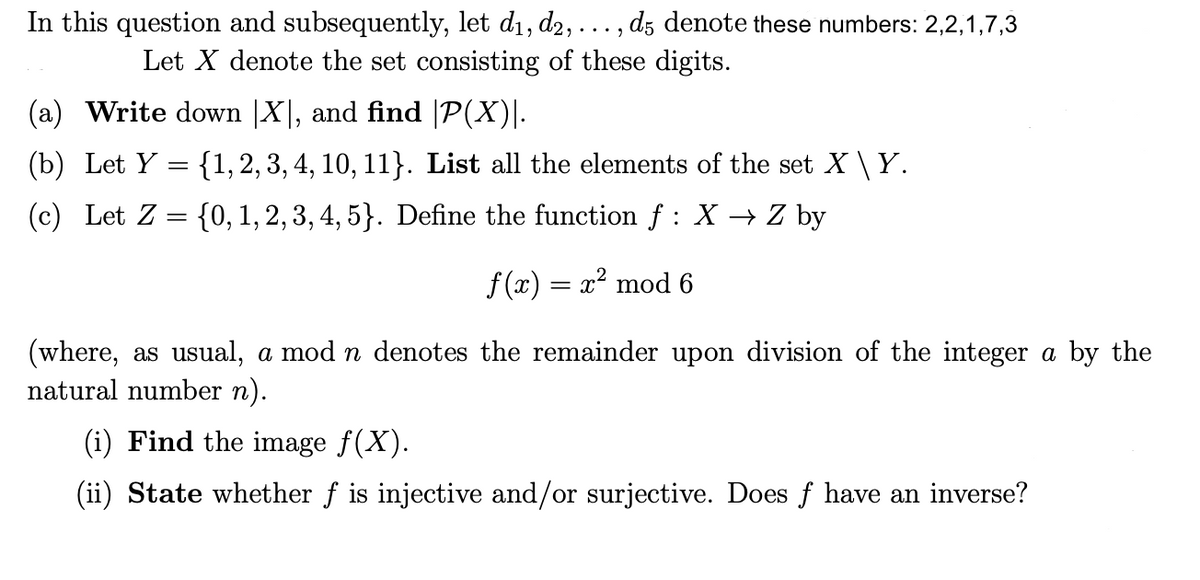this question and subsequently, let a₁, A2,..., a5 denote these numbers: 2,2,1,7,3 Let X denote the set consisting of these digits. a) Write down |X|, and find |P(X)|. b) Let Y = {1, 2, 3, 4, 10, 11}. List all the elements of the set X\ Y. c) Let Z = {0, 1, 2, 3, 4, 5}. Define the function f : X → Z by f(x) = x² mod 6 where, as usual, a mod n denotes the remainder upon division of the integer a by the atural number n). (i) Find the image f(X). (ii) State whether f is injective and/or surjective. Does ƒ have an inverse?
this question and subsequently, let a₁, A2,..., a5 denote these numbers: 2,2,1,7,3 Let X denote the set consisting of these digits. a) Write down |X|, and find |P(X)|. b) Let Y = {1, 2, 3, 4, 10, 11}. List all the elements of the set X\ Y. c) Let Z = {0, 1, 2, 3, 4, 5}. Define the function f : X → Z by f(x) = x² mod 6 where, as usual, a mod n denotes the remainder upon division of the integer a by the atural number n). (i) Find the image f(X). (ii) State whether f is injective and/or surjective. Does ƒ have an inverse?
Elements Of Modern Algebra
8th Edition
ISBN:9781285463230
Author:Gilbert, Linda, Jimmie
Publisher:Gilbert, Linda, Jimmie
Chapter1: Fundamentals
Section1.7: Relations
Problem 13E: 13. Consider the set of all nonempty subsets of . Determine whether the given relation on is...
Related questions
Question

Transcribed Image Text:...9
In this question and subsequently, let d₁, d2, . d5 denote these numbers: 2,2,1,7,3
Let X denote the set consisting of these digits.
(a) Write down |X|, and find |P(X)|.
(b) Let Y= {1, 2, 3, 4, 10, 11}. List all the elements of the set X \ Y.
(c) Let Z = {0, 1, 2, 3, 4, 5}. Define the function f : X → Z by
f(x) = x² mod 6
(where, as usual, a mod n denotes the remainder upon division of the integer a by the
natural number n).
(i) Find the image ƒ(X).
(ii) State whether f is injective and/or surjective. Does f have an inverse?
Expert Solution
This question has been solved!
Explore an expertly crafted, step-by-step solution for a thorough understanding of key concepts.
Step by step
Solved in 2 steps with 1 images

Recommended textbooks for you

Elements Of Modern Algebra
Algebra
ISBN:
9781285463230
Author:
Gilbert, Linda, Jimmie
Publisher:
Cengage Learning,

Elements Of Modern Algebra
Algebra
ISBN:
9781285463230
Author:
Gilbert, Linda, Jimmie
Publisher:
Cengage Learning,